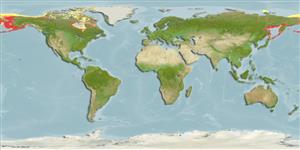Environment: milieu / climate zone / depth range / distribution range
экология
морской демерсальный; пределы глубины 0 - 100 m (Ref. 50550), usually 10 - 70 m (Ref. 56527). Temperate; 88°N - 40°N, 135°E - 60°W
North Pacific: Hokkaido, Japan and Sea of Okhotsk to the Bering Sea. Arctic Canada.
Size / Вес / Возраст
Maturity: Lm ? range ? - ? cm
Max length : 112 cm TL самец/пол неопределен; (Ref. 56527)
колючие лучи спинного плавника (общее число): 83 - 88; колючие лучи анального плавника 0; членистые (мягкие) лучи анального плавника: 53 - 54. Four pairs of strong canines on anterior parts of both jaws; molar teeth on prevomerine and palatal bones and posterior part of lower jaw. Dorsal fin without soft rays. Pelvic fins absent.
Found on rocky bottoms (Ref. 559). Benthic (Ref. 58426). Feeds on hard-shelled invertebrates (Ref. 28499).
Life cycle and mating behavior
половая зрелость | размножение | нерест | икра | Fecundity | личинки
Eggs are very large.
Masuda, H., K. Amaoka, C. Araga, T. Uyeno and T. Yoshino, 1984. The fishes of the Japanese Archipelago. Vol. 1. Tokai University Press, Tokyo, Japan. 437 p. (text). (Ref. 559)
Статус Красного Списка МСОП (Ref. 130435)
Угроза для людей
Harmless
Использование человеком
дополнительная информация
ссылкиаквакультура (рыбоводство)особенности рыбоводствастепень растяжениягенетикаElectrophoresesнаследуемостьболезниобработкаNutrientsMass conversion
соавторыизображенияStamps, Coins Misc.звукиCiguateraскоростьтип плаванияжаберная областьOtolithsмозгзрение
инструменты
Специальные отчеты
Скачать в формате XML
ресурсы в Интернет
Estimates based on models
Preferred temperature (Ref.
123201): -0.6 - 6.9, mean 2.3 °C (based on 1276 cells).
Phylogenetic diversity index (Ref.
82804): PD
50 = 0.5938 [Uniqueness, from 0.5 = low to 2.0 = high].
Bayesian length-weight: a=0.00398 (0.00174 - 0.00913), b=3.17 (2.97 - 3.37), in cm total length, based on LWR estimates for this (Sub)family-body shape (Ref.
93245).
Trophic level (Ref.
69278): 3.8 ±0.4 se; based on diet studies.
устойчивость к внешним воздействиям (Ref.
120179): низкий, минимальное время удвоения популяции 4.5-14 лет (Assuming tm>5).
Fishing Vulnerability (Ref.
59153): High to very high vulnerability (67 of 100).
